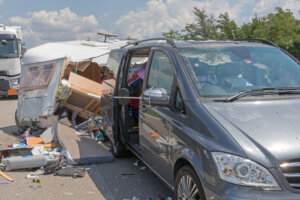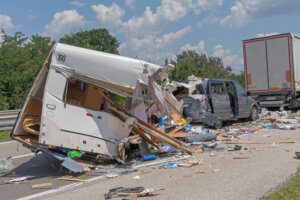By: Brian Johnson
In the world of RVing, it’s easy to view risks as isolated incidents—a sudden tire blowout, an unexpected steep descent, or a brief moment of distraction. However, much like in aviation, risks in RVing don’t merely add up; they multiply. This compounding effect means that multiple small risk factors can converge, leading to catastrophic outcomes.
A recent tragedy near Ronald Reagan Washington National Airport serves as a poignant example. On January 29, 2025, an American Airlines passenger jet collided midair with a U.S. Army Black Hawk helicopter over the Potomac River, resulting in the loss of all 67 individuals on both aircraft. Initial investigations revealed that the helicopter was flying above its authorized altitude, placing it in the flight path of the descending jet. This incident underscores how multiple factors—airspace complexity, pilot errors, and regulatory oversights—can align to produce disastrous results. (ksn.com)
The Parallel in RVing
RVing operates under a similar principle. Each additional variable—be it adverse weather, road hazards, mechanical issues, driver fatigue, or distractions—can interact in unforeseen ways, escalating the potential for accidents. Recognizing and addressing these compounding risks is crucial for safe travel.
How Risks Multiply in RVing
Consider this scenario:
- Extended Driving Hours: Pushing beyond planned travel times leads to fatigue.
- Adverse Weather: Sudden rain reduces visibility and road traction.
- Challenging Terrain: Navigating through construction zones with narrow lanes.
- Driver Distraction: A momentary lapse in attention due to in-cabin activities.
Individually, each factor presents a manageable risk. Combined, they create a situation where the likelihood of an incident increases exponentially.


Breaking the Chain of Risk
The key to safe RVing lies in proactively identifying and mitigating these risks before they converge. Here’s how:
- Prioritize Rest
- Plan travel itineraries that include regular breaks.
- Avoid driving during hours when alertness naturally wanes.
- Stay Informed About Conditions
- Regularly check weather forecasts and road reports.
- Be prepared to adjust routes or schedules in response to changing conditions.
- Conduct Thorough Pre-Trip Inspections
- Examine tires, brakes, lights, and fluid levels before each journey.
- Address any maintenance issues promptly to prevent breakdowns.
- Minimize Distractions
- Assign a passenger to handle navigation and communication tasks.
- Keep the driver’s focus solely on the road.
- Plan for Emergencies
- Familiarize yourself with alternative routes and nearby services.
- Equip your RV with emergency supplies, including first aid kits and tools.
Final Takeaway: Proactive Safety Reduces Risk
The tragic midair collision over Washington, D.C., illustrates how multiple small oversights can align to produce a catastrophic event. In RVing, understanding that risks compound rather than simply add allows travelers to take proactive steps to break the chain of potential incidents. By staying vigilant, prepared, and informed, RVers can ensure safer journeys and enjoy the open road with greater peace of mind.
